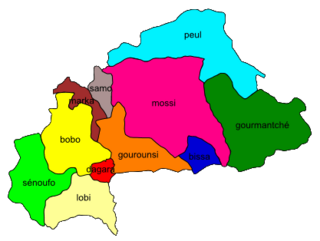| Dagaare | |
|---|---|
| Native to | Ghana, Burkina Faso, Ivory Coast, Cameroon |
| Ethnicity | Dagaaba people |
Native speakers | (1.3 million cited 1999–2021)[1] |
| Dialects |
|
| Latin (Dagaare alphabet) Dagaare Braille | |
| Language codes | |
| ISO 639-3 | Variously:dga – Southern Dagaaredgd – Dagaari Diouladgi – Northern Dagara |
| Glottolog | sout2789 Central Dagaaredaga1272 Dagaari Dioulanort2780 Northern Dagara |
 Majority areas of Northern Dagara speakers, in red, on a map of Burkina Faso. | |
Dagaare is the language of the Dagaaba people of Ghana, Burkina Faso, and Ivory Coast. It has been described as a dialect continuum that also includes Waale and Birifor. Dagaare language varies in dialect stemming from other family languages including: Dagbane, Waale, Mabia, Gurene, Mampruli, Kusaal, Buli, Niger-Congo, and many other sub languages resulting in around 1.3 million Dagaare speakers.[1] Throughout the regions of native Dagaare speakers the dialect comes from Northern, Central, Western, and Southern areas referring to the language differently. Burkina Faso refers to Dagaare as Dagara and Birifor to natives in the Republic of Côte d'Ivoire. The native tongue is still universally known as Dagaare. Amongst the different dialects, the standard for Dagaare is derived from the Central region's dialect. Southern Dagaare (or Waale) also stems from the Dagaare language and is known to be commonly spoken in Wa and Kaleo.
Ethnologue divides Dagaare into three languages:
- Southern/Central Dagaare language, which is spoken mainly in Ghana
- Northern Dagara language, which is spoken mainly in Burkina Faso
- Dagaari Dioula, which is spoken mainly in Burkina Faso, and has significant influence from the genetically unrelated Dioula language
- ^ a b Southern Dagaare at Ethnologue (26th ed., 2023)

Dagaari Dioula at Ethnologue (26th ed., 2023)
Northern Dagara at Ethnologue (26th ed., 2023)
